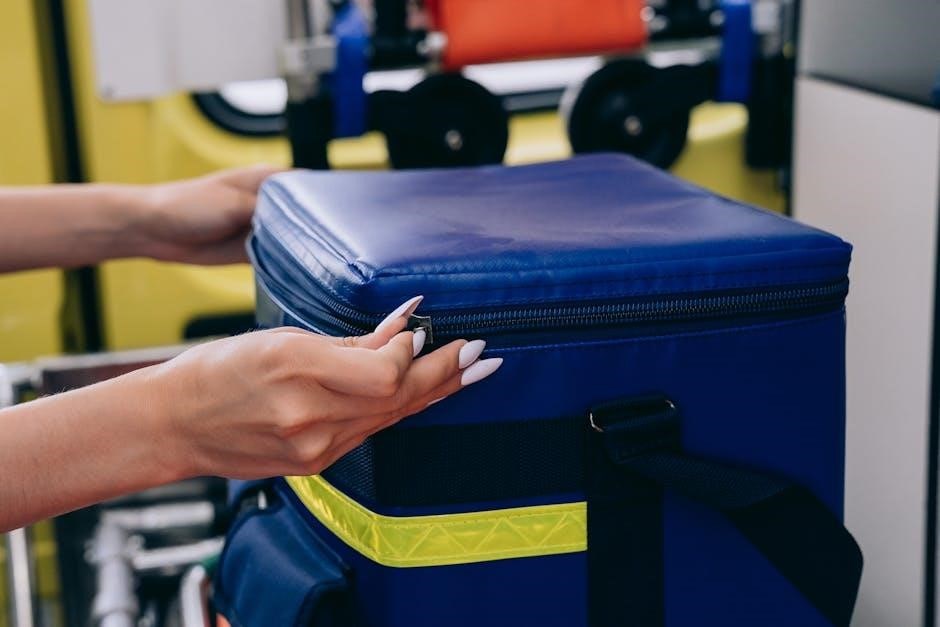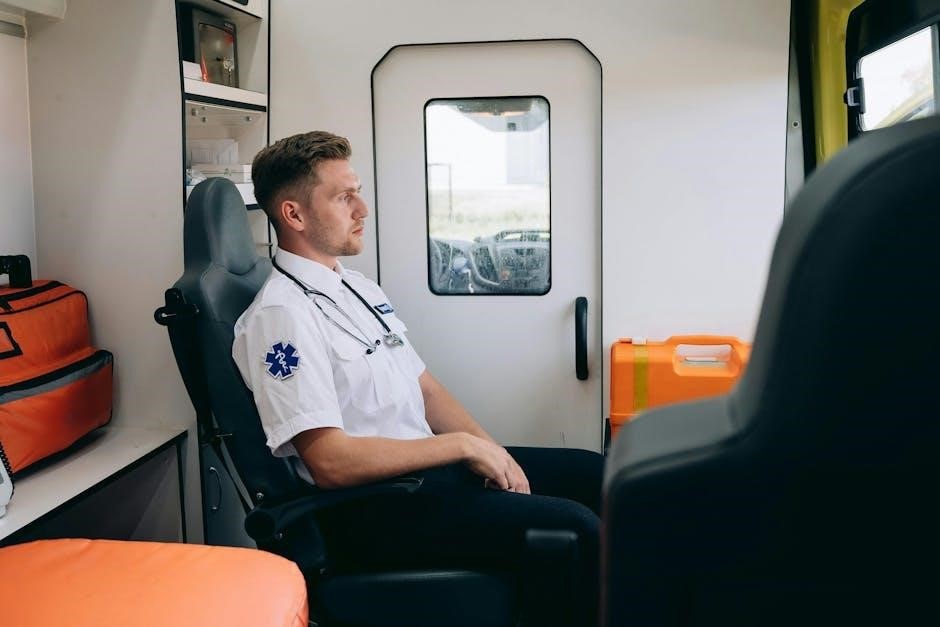The Emergency Preparedness Merit Badge empowers Scouts to stay safe and help others during crises. This workbook guides them through preparing emergency kits, creating plans, and understanding first aid.
Overview of the Merit Badge
The Emergency Preparedness Merit Badge is designed to help Scouts understand and prepare for various emergencies. It focuses on safety, readiness, and community service. Scouts learn to create emergency kits, develop family plans, and understand first aid. The workbook serves as a tool to guide Scouts through requirements, ensuring they meet all necessary tasks. It emphasizes practical steps like building a family emergency kit and creating a mobilization plan. The badge also requires earning the First Aid Merit Badge, demonstrating a commitment to health and safety. By completing this merit badge, Scouts gain essential skills to protect themselves and others during crises. The workbook is available in PDF format, making it accessible for Scouts to organize their progress and achieve readiness.

Importance of Emergency Preparedness
Emergency preparedness is crucial for ensuring safety and minimizing risks during crises. It equips individuals with the knowledge and skills to respond effectively, protecting themselves and others. By being prepared, Scouts can serve as leaders in their communities, helping others stay safe. The workbook emphasizes the importance of readiness, teaching Scouts to anticipate and manage emergencies. Preparedness fosters confidence and resilience, enabling Scouts to handle unexpected situations calmly. It also strengthens community bonds by encouraging collective planning and support. The merit badge program highlights the value of proactive measures, ensuring Scouts are ready to act when emergencies arise. Through this training, Scouts become valuable assets in emergency response and recovery efforts.

Key Requirements for the Emergency Preparedness Merit Badge
Earn the First Aid Merit Badge, prepare a personal emergency pack, and develop a family emergency plan. Complete a service project and demonstrate emergency response skills.

Earning the First Aid Merit Badge
Earning the First Aid Merit Badge is a critical step in achieving the Emergency Preparedness Merit Badge. Scouts must demonstrate a thorough understanding of basic first aid skills, including wound care, splinting, and CPR. They must also show how to respond to common injuries and illnesses, such as burns, fractures, and choking. Additionally, Scouts are required to explain how to prevent injuries and promote safety in various situations. The workbook provides detailed checklists and exercises to help Scouts master these skills. By completing this requirement, Scouts gain the confidence and knowledge to provide essential care during emergencies, making it a fundamental part of the Emergency Preparedness Merit Badge program.
Preparing a Personal Emergency Service Pack
Preparing a personal emergency service pack is essential for Scouts to be ready for mobilization. This pack should include a first aid kit, water, flashlight, extra clothing, and communication tools. Scouts must explain the needs and uses of each item, ensuring they understand the importance of being prepared. The workbook provides checklists to help Scouts assemble and organize their packs effectively. This step teaches practical skills in anticipation of emergencies, ensuring Scouts can respond confidently and assist others in crisis situations. By completing this requirement, Scouts demonstrate their ability to think critically and act responsibly during critical moments.
Developing a Family Emergency Plan
Developing a family emergency plan is a critical step in ensuring everyone’s safety during crises. Scouts learn to identify escape routes, designate a meeting point, and establish communication methods. The plan should include a map of the home with marked exits, a list of emergency contacts, and a safe gathering location. Scouts are encouraged to review and practice the plan with their families to ensure preparedness. The workbook provides templates to document these details, making it easier to create a comprehensive strategy. By involving all family members, Scouts help build a culture of readiness and responsibility, ensuring everyone knows what to do in case of an emergency.

Using the Emergency Preparedness Merit Badge Workbook
The workbook helps Scouts organize their progress, track requirements, and prepare for the merit badge. It includes form fields for notes and is a valuable supplementary tool.
Understanding the Workbook Structure
The Emergency Preparedness Merit Badge Workbook is designed to guide Scouts through the requirements systematically. It features form fields for notes, making it easy to track progress digitally. The workbook aligns with the official pamphlet, ensuring Scouts cover all necessary topics. Each requirement is broken down into sections, allowing Scouts to document their efforts and reflections. Checklists and spaces for evidence, such as completed emergency kits or family plans, help maintain organization. The workbook also includes tips for leaders and counselors to support Scouts effectively. While it simplifies the process, Scouts must still read the pamphlet for full understanding. Available as a downloadable PDF, the workbook is a valuable tool for achieving the merit badge and fostering preparedness skills.
Completing the Requirements Section
Completing the requirements section of the Emergency Preparedness Merit Badge Workbook involves thorough documentation and active participation. Scouts must demonstrate proficiency in first aid, prepare emergency kits, and develop family evacuation plans. Each requirement includes specific tasks, such as explaining the contents of a kit or outlining escape routes. Scouts must also engage in simulations and real-world applications, like participating in drills or assisting in community preparedness initiatives. The workbook provides structured spaces for recording evidence, such as checklists, drawings, and written explanations. Leaders and counselors review these entries to ensure all criteria are met. By systematically addressing each requirement, Scouts build a comprehensive understanding of emergency preparedness, equipping them to respond confidently in crises. This hands-on approach ensures practical skills are developed alongside theoretical knowledge.

Tips for Scout Leaders and Counselors

Scout leaders and counselors play a vital role in guiding Scouts through the Emergency Preparedness Merit Badge. Encourage Scouts to review the workbook requirements thoroughly before starting. Utilize the official BSA pamphlet and supplementary resources like the American Red Cross guides to enrich learning. Conduct regular check-ins to monitor progress and provide constructive feedback. Emphasize hands-on activities, such as simulations and drills, to reinforce practical skills. Foster collaboration among Scouts by organizing group discussions and shared projects. Ensure Scouts understand the importance of each requirement and its real-world applications. By providing clear guidance and support, leaders can help Scouts achieve a deep understanding of emergency preparedness, enabling them to respond confidently in critical situations.

Additional Resources for Emergency Preparedness
The official BSA Emergency Preparedness Merit Badge Pamphlet, American Red Cross guides, and online tools like workbooks and workshops provide essential resources for Scouts and leaders to enhance preparedness skills.
Official BSA Merit Badge Pamphlet
The official BSA Emergency Preparedness Merit Badge Pamphlet is a comprehensive guide for Scouts, providing detailed instructions and requirements to earn the badge. It covers essential topics such as first aid, emergency kits, and family plans. The pamphlet is updated annually to reflect the latest safety practices and recommendations from experts. Scouts and leaders can rely on it as the primary resource for understanding the badge’s requirements. Additionally, it includes practical advice on how to stay prepared for various emergencies, making it an invaluable tool for both individual and group preparedness efforts. The pamphlet aligns with the workbook, ensuring a structured approach to completing the merit badge requirements.
American Red Cross Emergency Preparedness Guides
The American Red Cross offers essential emergency preparedness guides that complement the BSA Emergency Preparedness Merit Badge Workbook. These resources provide detailed instructions on creating emergency kits, developing evacuation plans, and understanding disaster-specific preparedness. The guides emphasize the importance of staying informed and proactive during crises. They align with the merit badge requirements, offering practical advice for Scouts and their families. The Red Cross materials also include tips for community preparedness and ways to stay safe during natural disasters. By using these guides alongside the workbook, Scouts can gain a deeper understanding of emergency readiness and develop critical skills to protect themselves and others. These resources are widely recognized for their effectiveness and are often recommended by merit badge counselors.
Online Tools and Workshops
Online tools and workshops provide valuable resources for Scouts working on the Emergency Preparedness Merit Badge. The BSA Emergency Preparedness Workbook PDF is a key resource, offering structured guidance for completing requirements. Websites like ScoutmasterBucky.com and VAHC online classes offer downloadable materials, including checklists and lesson plans. These tools help Scouts organize their efforts and track progress. Additionally, interactive workshops and webinars cover topics like emergency kit assembly and family evacuation plans. Online platforms also provide access to tutorials and expert advice, ensuring Scouts are well-prepared for real-world scenarios. These digital resources enhance traditional materials, making it easier for Scouts to earn the merit badge while staying engaged and informed. They are especially useful for Scouts who prefer self-paced learning or need additional support.

Practical Steps for Emergency Preparedness
Assemble emergency kits, develop evacuation plans, and practice drills to ensure readiness. These steps help Scouts act quickly and confidently during crises, saving lives and reducing risks.
Building a Family Emergency Kit
A family emergency kit ensures everyone is prepared for crises. Include essentials like water (1 gallon per person/day for 3 days), non-perishable food, a first aid kit, flashlight, batteries, and medications. Add personal documents (ID, insurance), a change of clothes, and cash. Don’t forget a portable phone charger and multipurpose tool. Customize for family members’ needs, such as diapers or pet supplies. Store the kit in a durable, easy-to-carry container. Review and update supplies every 6 months to ensure freshness and relevance. Scouts play a key role in helping their families assemble and maintain these kits, promoting readiness and safety. Regular drills ensure everyone knows the kit’s location and contents, fostering confidence in emergencies.
Creating a Mobilization Plan for Scouts
A mobilization plan ensures Scouts are ready to respond swiftly in emergencies. Develop a clear communication strategy, assigning roles like leader, first aid specialist, and logistics coordinator. Identify assembly points and evacuation routes. Practice drills to ensure smooth execution. Include a checklist for essential items like a first aid kit, water, and tools. Scouts should know their responsibilities and how to stay informed. Regular updates and adaptability are crucial for effectiveness. The workbook guides Scouts in crafting and reviewing these plans, ensuring they are prepared for various scenarios. A well-organized plan fosters teamwork and readiness, enabling Scouts to act confidently during emergencies. Preparation is key to saving lives and providing support when needed most.